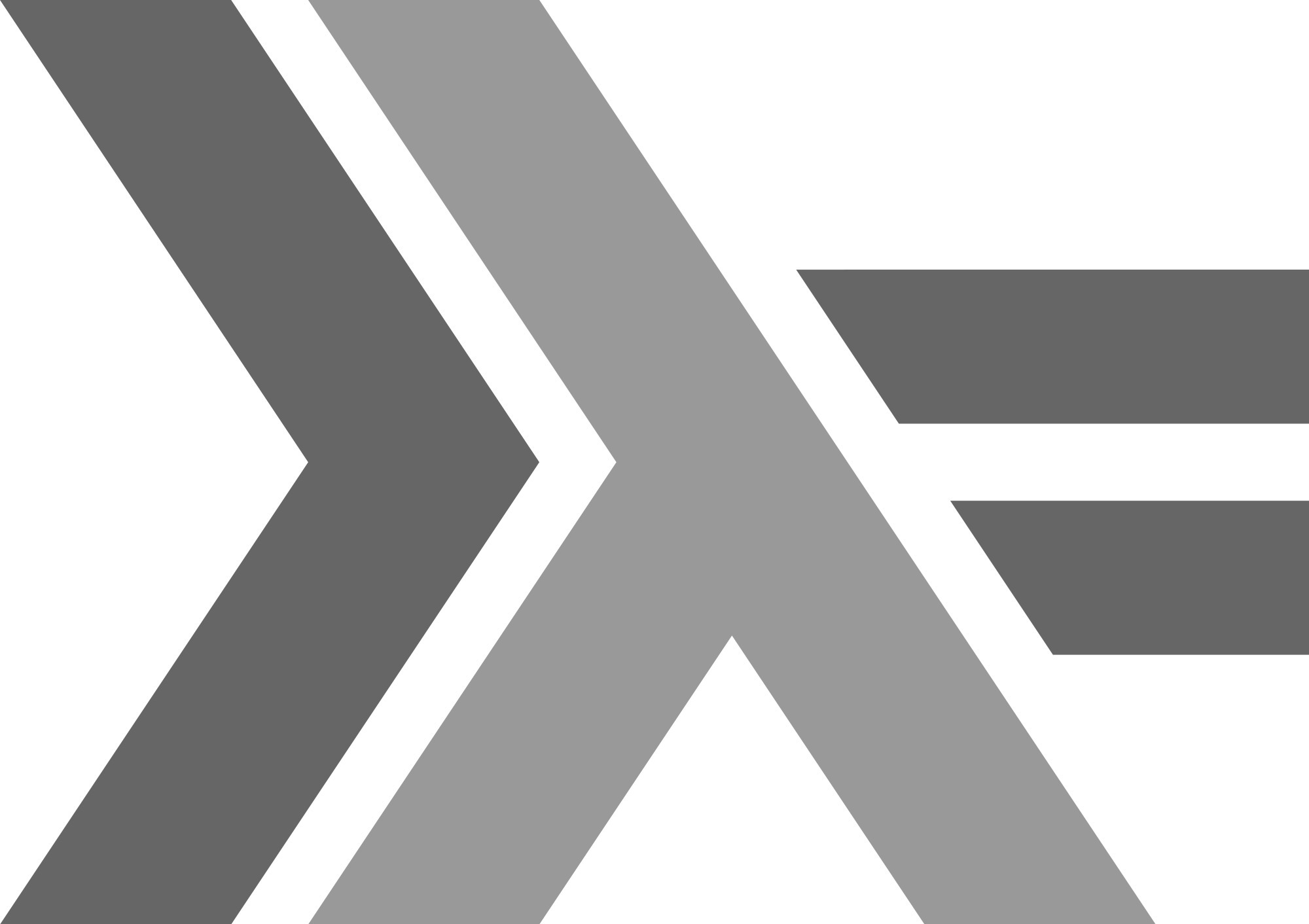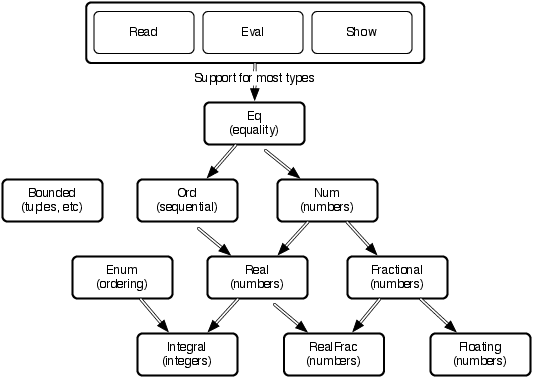15 KiB
Seven Languages in Seven Weeks
Introduction
Haskell

Introduction
Haskell BMCOL
- Created
- 1990
- Author
- A committee of researchers and application programmers, including John Hughes, Simon Peyton Jones, and Philip Wadler.
Spock BMCOL

Getting Haskell
Day 1
Day 1: Logical
Haskell is a functional programming language. Its first distinguishing characteristic is that it is a pure functional language. A function with the same arguments will always produce the same result.
- Expressions
- Types
- Functions
- Tuples and Lists
- Function Composition
- List Comprehensions
Expressions and Primitive Types
Numbers
4 -- 4
4 + 1 -- 5
4 + 1.0 -- 5.0
4 + 2.0 * 5 -- 14.0Strings
"hello" ++ " world" -- "hello world"
'a' -- 'a'
['a', 'b'] -- "ab"Booleans
(4 + 5) == 9 -- True
(5 + 5) /= 10 -- False
if (5 == 5) then "true" else "false" -- "true"Type Errors
if
if 1 then "true" else "false"<interactive>:115:4:
No instance for (Num Bool) arising from the literal ‘1’
In the expression: 1
In the expression: if 1 then "true" else "false"
In an equation for ‘it’: it = if 1 then "true" else "false"
+
"one" + 1<interactive>:121:7:
No instance for (Num [Char]) arising from a use of ‘+’
In the expression: "one" + 1
In an equation for ‘it’: it = "one" + 1Functions
Simple
let double x = x + x
double 24 :t doubledouble :: Num a => a -> aRecursive
factorial :: Integer -> Integer
factorial x
| x > 1 = x * factorial (x - 1)
| otherwise = 1Tuples
Code
module Main where
fibTuple :: (Integer, Integer, Integer) -> (Integer, Integer, Integer)
fibTuple (x, y, 0) = (x, y, 0)
fibTuple (x, y, index) = fibTuple (y, x + y, index - 1)
fibResult :: (Integer, Integer, Integer) -> Integer
fibResult (x, y, z) = x
fib :: Integer -> Integer
fib x = fibResult (fibTuple (0, 1, x))Results
:l fib_tuple
fib 100354224848179261915075Tuples and Composition
module Main where
fibNextPair :: (Integer, Integer) -> (Integer, Integer)
fibNextPair (x, y) = (y, x + y)
fibNthPair :: Integer -> (Integer, Integer)
fibNthPair 1 = (1, 1)
fibNthPair n = fibNextPair (fibNthPair (n - 1))
fib :: Integer -> Integer
fib = fst . fibNthPairTraversing Lists
Pattern Matching
let (h:t) = [1, 2, 3 4]
-- h = 1
-- t = [2,3,4]Recursive Traversal
size [] = 0
size (h:t) = 1 + size t
prod [] = 1
prod (h:t) = h * prod tZip
zip ["kirk", "spock"] ["enterprise", "reliant"]
-- [("kirk","enterprise"),("spock","reliant")]Generating Lists
Recursion
allEven :: [Integer] -> [Integer]
allEven [] = []
allEven (h:t) = if even h then h:allEven t else allEven tRanges and Composition
Ranges BMCOL
[1..4] -- [1,2,3,4]
[10..4] -- []
[10, 8 .. 4] -- [10,8,6,4]Composition BMCOL
take 5 [1..] -- [1,2,3,4,5]
take 5 [0, 2..] -- [0,2,4,6,8]List Comprehensions
[x * 2 | x <- [1, 2, 3]] -- [2,4,6]
[(4 - x, y) | (x, y) <- [(1, 2), (2, 3), (3, 1)]] -- [(3,2),(2,3),(1,1)]
let crew = ["Kirk", "Spock", "McCoy"]
[(a, b) | a <- crew, b <- crew, a < b]
-- [("Kirk","Spock"),("Kirk","McCoy"),("McCoy","Spock")]An Interview with Philip Wadler
The original goals were not modest: we wanted the language to be a foundation for research, suitable for teaching, and up to industrial uses.
Day 2
Day 2: Spock's Greatest Strength
Haskell's great strength is also that predictability and simplicity of logic. Many universities teach Haskell in the context of reasoning about programs. Haskell makes creating proofs for correctness far easier than imperative counterparts.
- Higher Order Functions
- Partial Application and Currying
- Lazy Evaluation
Higher-Order Functions
Anonymous Functions
(\x -> x ++ " captain.") "Logical, "
-- "Logical, captain."
map and where
squareAll list = map square list
where square x = x * x
squareAll [1, 2, 3] -- [1,4,9]
map (+ 1) [1, 2, 3] -- [2,3,4]
filter, foldl, foldr
filter odd [1, 2, 3, 4, 5] -- [1,3,5]
foldl (\x carryOver -> carryOver + x) 0 [1 .. 10] -- 55
foldl (+) 0 [1 .. 3] -- 6Partial Application and Currying
let prod x y = x * y
:t prodprod :: Num a => a -> a -> alet double = prod 2
let triple = prod 3
double 3 -- 6
triple 4 -- 12
So, the mystery is solved. When Haskell computes prod 2 4, it is
really computing (prod 2) 4, like this:
- First, apply
prod 2. That returns the function(\y -> 2 * y). - Next, apply
(\y -> 2 * y) 4, or2 * 4, giving you 8.
Lazy Evaluation
let lazyFib x y = x:(lazyFib y (x + y))
let fib = lazyFib 1 1
let fibNth x = head (drop (x - 1) (take (x) fib))
take 5 (fib) -- [1,1,2,3,5]
take 5 (drop 20 (lazyFib 0 1)) -- [6765,10946,17711,28657,46368]
take 5 (map ((* 2) . (* 5)) fib) -- [10,10,20,30,50]Composition B_block
In Haskell, f . g x is shorthand for f(g x).
An Interview with Simon Peyton-Jones
Apart from purity, probably the most unusual and interesting feature of Haskell is its type system. Static types are by far the most widely used program verification technique available today: millions of programmers write types (which are just partial specifications) every day, and compilers check them every time they compile the program. Types are the UML of functional programming: a design language that forms an intimate and permanent part of the program.
Day 3
Day 3: The Mind Meld
- Classes and Types
- Monads
Basic Types
'c' :: Char
"abc" :: [Char]
['a', 'b', 'c'] :: [Char]
True :: Bool
False :: BoolUser-Defined Types
data Suit = Spades | Hearts
deriving Show
data Rank = Ten | Jack | Queen | King | Ace
deriving Show
type Card = (Rank, Suit)
type Hand = [Card]
value :: Rank -> Integer
value Ten = 1
value Jack = 2
value Queen = 3
value King = 4
value Ace = 5
cardValue :: Card -> Integer
cardValue (rank, suit) = value rankFunctions and Polymorphism
Generic Functions
backwards [] = []
backwards (h:t) = backwards t ++ [h]Could be typed as
backwards :: Hand -> Handor
backwards :: [a] -> [a]Polymorphic Data Types
data Triplet a = Trio a a a deriving (Show)Could be used as:
Trio 'a' 'b' 'c' :: Triplet CharRecursive Types
Defining a tree data type
data Tree a = Children [Tree a]
| Leaf a
deriving (Show)Constructing and deconstructing a tree of integers
let tree = Children [Leaf 1, Children [Leaf 2, Leaf 3]] :: Tree Integer
let (Children ch) = tree
-- ch = [Leaf 1, Children [Leaf 2, Leaf 3]]
let (fst:tail) = ch
-- fst = Leaf 1Calculating the depth of a tree
depth (Leaf _) = 1
depth (Children c) = 1 + maximum (map depth c)Classes
- It's not an object-oriented class, because there's no data involved.
- A class defines which operations can work on which inputs.
- A class provides some function signatures. A type is an instance of a class if it supports all those functions.
class Eq a where
(==), (/=) :: a -> a -> Bool
-- Minimal complete definition:
-- (==) or (/=)
x /= y = not (x == y)
x == y = not (x /= y)Class Inheritance

Monads
The Problem: Drunken Pirate
def treasure_map(v)
v = stagger(v)
v = stagger(v)
v = crawl(v)
return(v)
end
We have several functions that we call within treasure_map that
sequentially transform our state, the distance traveled. The problem
is that we have mutable state.
The Problem: Drunken Pirate
module Main where
stagger :: (Num t) => t -> t
stagger d = d + 2
crawl d = d + 1
treasureMap d =
crawl (
stagger (
stagger d))
letTreasureMap (v, d) = let d1 = stagger d
d2 = stagger d1
d3 = crawl d2
in d3
The inputs and outputs are the same, so it should be easier to compose
these kinds of functions. We would like to translate
stagger(crawl(x)) into stagger(x) · crawl(x), where · is
function composition. That's a monad.
Components of a Monad
At its basic level, a monad has three basic things:
- A type constructor that's based on some type of container. The container could be a simple variable, a list, or anything that can hold a value. We will use the container to hold a function. The container you choose will vary based on what you want your monad to do.
- A function called
returnthat wraps up a function and puts it in the container. The name will make sense later, when we move intodonotation. Just remember thatreturnwraps up a function into a monad. - A bind function called
>>=that unwraps a function. We'll use bind to chain functions together.
Monadic Laws
All monads will need to satisfy three rules. I'll mention them briefly
here. For some monad m, some function f, and some value x:
- You should be able to use a type constructor to create a monad that will work with some type that can hold a value.
- You should be able to unwrap and wrap values without loss of
information. (
monad >>return = monad=) - Nesting bind functions should be the same as calling them
sequentially. (
(m >>f) >>= g = m >>= (\x -> f x >>=
Building a Monad from Scratch
module Main where
data Position t = Position t deriving (Show)
stagger (Position d) = Position (d + 2)
crawl (Position d) = Position (d + 1)
rtn x = x
x >>== f = f x
treasureMap pos = pos >>==
stagger >>==
stagger >>==
crawl >>==
rtn
Monads and do Notation
module Main where
tryIo = do putStr "Enter your name: " ;
line <- getLine ;
let { backwards = reverse line } ;
return ("Hello. Your name backwards is " ++ backwards)List Monad
instance Monad [] where
m >>= f = concatMap f m
return x = [x] let cartesian (xs,ys) = do x <- xs; y <- ys; return (x,y)
cartesian ([1..2], [3..4])
-- [(1,3),(1,4),(2,3),(2,4)]Password Cracker B_example
module Main where
crack = do x <- ['a'..'c'] ; y <- ['a'..'c'] ; z <- ['a'..'c'] ;
let { password = [x, y, z] } ;
if attempt password
then return (password, True)
else return (password, False)
attempt pw = if pw == "cab" then True else FalseMaybe Monad
In this section, we'll look at the Maybe monad. We'll use this one
to handle a common programming problem: some functions might fail.
data Maybe a = Nothing | Just a
instance Monad Maybe where
return = Just
Nothing >>= f = Nothing
(Just x) >>= f = f xUsing the Maybe Monad
Without a monad
case (html doc) of
Nothing -> Nothing
Just x -> case body x of
Nothing -> Nothing
Just y -> paragraph 2 yWith the Maybe monad
Just someWebpage >>= html >>= body >>= paragraph >>= returnRailway-Oriented Programming B_note
Wrapping Up
Wrapping Up Haskell: Strengths
- Type System
- Expressiveness
- Purity of Programming Model
- Lazy Semantics
- Academic Support
Wrapping Up Haskell: Weaknesses
- Inflexibility of Programming Model
- Community
- Learning Curve
Final Thoughts
Of the functional languages in the book, Haskell was the most difficult to learn. The emphasis on monads and the type system made the learning curve steep. Once I mastered some of the key concepts, things got easier, and it became the most rewarding language I learned. Based on the type system and the elegance of the application of monads, one day we’ll look back at this language as one of the most important in this book.
Haskell plays another role, too. The purity of the approach and the academic focus will both improve our understanding of programming. The best of the next generation of functional programmers in many places will cut their teeth on Haskell.